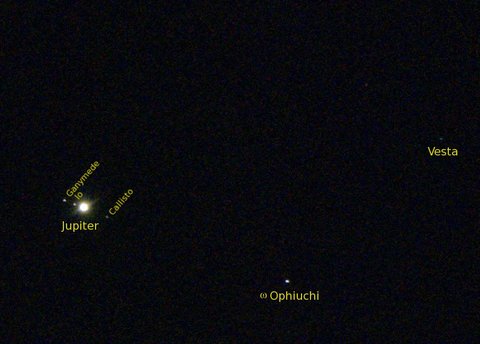« Reading List: Entangled Minds | Main | Reading List: America's Last Days »
Saturday, August 25, 2007
Astronomy: Viewing Vesta
If you've never seen an asteroid, the next few days present an excellent opportunity to remedy that lacuna. Asteroid 4 Vesta is the second most massive asteroid in the main belt, but, with a more reflective surface than dwarf planet 1 Ceres, is the brightest of the asteroids—in late May and early June Vesta reached magnitude 5.4 and was visible to the unaided eye in a dark and transparent sky. It's faded now to magnitude 7.2, which is easily visible in binoculars or a small telescope, and over the next few days will be exceptionally easy to spot because it will be gliding past brilliant Jupiter in the southwest sky at dusk for observers in the northern hemisphere. On August 30th at 4h Universal Time, Vesta will be just 24 arc-minutes from Jupiter. If you aim your binoculars at Jupiter, you'll see Jupiter, its Galilean moons, the magnitude 4.6 star ω Ophiuchi, and Vesta within the five degree field of view typical for binoculars. This page (scroll down to “August 24–31”) provides day-by-day descriptions of the encounter for observers in the U.K., which are applicable for anywhere in the mid-latitudes of the northern hemisphere; the further south your latitude, the higher Jupiter will be in the sky and the more time you'll have before it sets. Update:
Click image for an enlargement.
Posted at August 25, 2007 13:58